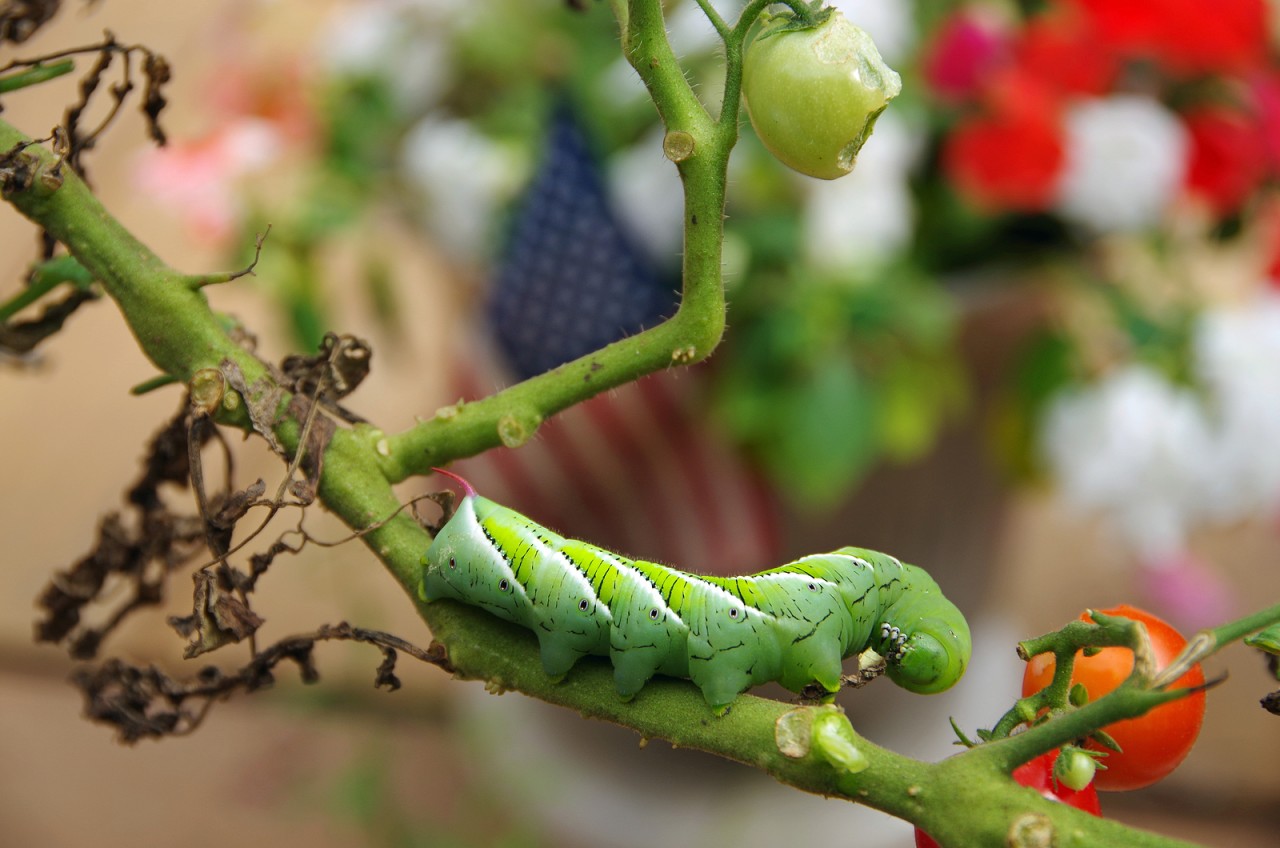Few garden pests are hated as much as the common tomato hornworm! These green-in-color caterpillars eventually turn into what is known as a hawk moth or sphinx moth and have white v-shaped markings and a distinct horn-like protrusion on their posterior ends. The adult forms can get very large, and they have the ability to completely defoliate a plant in short amount of time. They feed on plants in the Solanaceae (nightshade) family including tomatoes, peppers, eggplant and potatoes. Not only do they completely strip a plant of its leaves, they also chew holes in the fruit and can cause devastating damage if left unremoved.
Each year we plant our garden and declare war! My husband is the one who is the hornworm expert. He loves competition, and since we try to not use chemicals on our gardens, we fight these pests by hand removing them. Over the past few years, it has become his daily ritual to inspect all of the plants for these destroyers. We keep a running total of how many he finds and removes. In 2019, the grand total was 124.
If you have two or three plants that are four-to-five feet tall, then locating these caterpillars isn’t terribly difficult. It becomes much more of a challenge when you have 50 to 60 plants, with some 14 to 15 feet tall. These pests love to work from the top down, so it often requires getting on a ladder to look for them. The caterpillar itself is sometimes difficult to locate, but the tell-tale sign that it has been there is in the condition it leaves behind.
Each branch where the hornworm has been is completely stripped. There are no leaves at all. At first glance you might overlook the damage because the plant is so dense, but when you step back and evaluate, the evidence is so distinct and pronounced that you cannot miss it. This garden pest may wish to remain hidden, but the evidence that it leaves behind is unmistakable. People can be like this as well.
In this fallen world, selfishness and hatefulness abound. Our actions are oftentimes thoughtless and mean. Words are sharp and are delivered with the intent to hurt. It’s easy for us as people to hide behind a keyboard or phone and ignore the pain that we cause. We tend to be impatient and demanding.
God tells us to live in a manner that is just the opposite. In I Cor. 13: 4-7 we read, “Love is patient, love is kind and is not jealous; love does not brag and is not arrogant, does not act unbecomingly; it does not seek its own, is not provoked, does not take into account a wrong suffered, does not rejoice in unrighteousness, but rejoices with the truth; bears all things, believes all things, hopes all things, endures all things.”
We should love so big and so kind and so differently than anything people have ever seen that when we walk away, we’ve left a mark that is life-changing and memorable. Jesus taught in John 13:35-36, “A new commandment I give to you, that you love one another, even as I have loved you, that you also love one another. By this, all men will know that you are My disciples, if you have love for one another.” The goal is not for us to huddle in our churches and comfort ourselves but rather to reach outside of the four walls and embrace the brokenness that is surrounding us. The condition that we leave behind should be evident that people know they were in the presence of a Christ-follower.
When we’re patient with people who do not deserve our patience, kind to those who treat us poorly and encourage those who we would rather tell to “kick rocks,” then we are showing Christ’s love to them. The mark we leave behind is like that of the hornworm, distinct and unmistakable. Once you’ve seen it, you can recognize it immediately. God help us.






